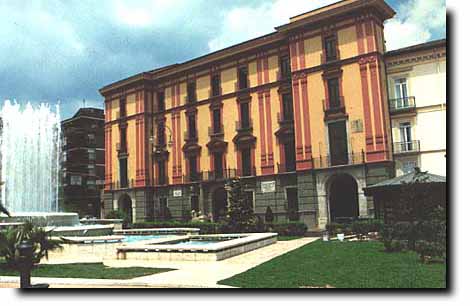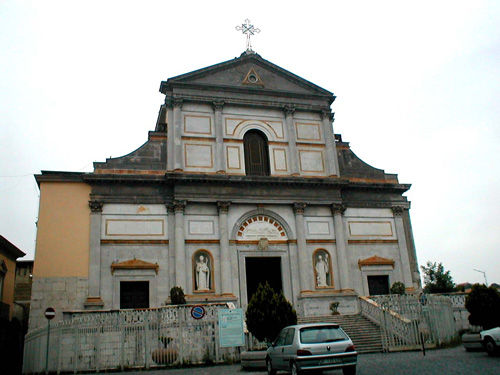|
The
history of Avellino
From 1581 to
the 1806 Avellino she is dominated by the Caracciolos under which it knows
a long season of demografic increase of urbanistic expansion and of economic
progress. They go up again to such period (1504) the to affirm him of
the art of the wool that filled Italy of the appreciated cloths of Avellino
from the typical color blue load. Subsequently the commerce found a monumental
center in the customs of the wheats. During the first century of their
Dominion the Caracciolos widened the Castle up to do a place of excellence
of it with a park of which you/they sang wonder poets and travellers.
The 1656 plague constituted nothing more than a wisecrack of arrest. In
the '700 the city starts to assume the today's urban with the abandonment
of the Castle. They are born the new residence of the Principles Caracciolo,
the actual center of the provincial administration and the principal course.

In the 1806 Avellino it is chief town of Province of Principality Ultra
stump of pertinence beneventana in contrasted Citra of pertinence to the
Principality salernitana and his/her political-economic weight it grows
up to the unity of Italy when a period of decadence starts, essentially
imputable to the isolation produced by the realization of the railroad
Naples - Benevento - Manner that makes to lose to the city that conquered
peculiar role of his of crossroad commeciale among two seas, between Puglia
and Campania. The little laced references that precede have in fact the
alone function to facilitate the discourse that him incentra on the visit
of the city. Which can depart from Amendola plaza in the heart of the
ancient Avellino. Here we find the Building of the Customs. Of the medieval
construction, avente sweeps commercial, residual only the façade.
The building was rehandled, on the sketch of the Fanzago, in 1657 for
initiative of the Prince F. Sea Caracciolo. The architect of Clusone also
drew the near tower Baroque Tower of the clock. Before the Building of
the customs is the monument to Charles II of Asburgo. You Cathedral built
in the sec. XII and referred more times up to 1868, introduces a neoclassic
façade. The inside is to Latin cross to three aisles. To signal the marbles appreciated of the most greater altar assumes him
represented in a shovel attributed to the Ricciardi, she is revered by
the avellinesis that they associate it to S.Modestino in the patronage
of the city, party on August 15, the tabernacle to reliefs of Giovanni
from Nola in the chapel to the right of the most greater aisle and, the
sixteenth-century carved wooden choir, sets in the apse and attributed
to C. Tortelli. Worthy of attention also the stately bell tower in big
blocks of alive stone where epigraphs and structures and Roman structures
are inserted coming from sepulchral monuments of Abellinum. From the sacristy
he brings under the Cathedral accessing the chiesetta of S.Maria of the
Seven Pains or crypt of the Our Lady of Sorrows, drawn, in the sec. XVII,
through addition of a small aisle in the native crypt of the Cathedral.
Not too far the Cathedral there is where the Building De Concilii it resided,
child, V. Hugo. In the church S. Maria of Constantinople we admire the
valuable marbles of the Baroque greater altar and the angels reggicandelabri,
therefore a Madonna with the Bambimo in Gloria. The Fountain of Constantinople
near Course Umberto in past introduced Belefonte astride the Chimera and
two feminine busts, of 1669. A little far we find the sixteenth-century
Fountain Tecta in stone with bas-reliefs. It deals with the remaking of
an ancient fountain of medieval age. Of the medieval Castle they don't
stay but the ruins, vast plinths of a building dismantled in the '700.
On Liberty plaza it looks out upon the eighteenth-century Building Caracciolo,
principles of Avellino.
To signal the marbles appreciated of the most greater altar assumes him
represented in a shovel attributed to the Ricciardi, she is revered by
the avellinesis that they associate it to S.Modestino in the patronage
of the city, party on August 15, the tabernacle to reliefs of Giovanni
from Nola in the chapel to the right of the most greater aisle and, the
sixteenth-century carved wooden choir, sets in the apse and attributed
to C. Tortelli. Worthy of attention also the stately bell tower in big
blocks of alive stone where epigraphs and structures and Roman structures
are inserted coming from sepulchral monuments of Abellinum. From the sacristy
he brings under the Cathedral accessing the chiesetta of S.Maria of the
Seven Pains or crypt of the Our Lady of Sorrows, drawn, in the sec. XVII,
through addition of a small aisle in the native crypt of the Cathedral.
Not too far the Cathedral there is where the Building De Concilii it resided,
child, V. Hugo. In the church S. Maria of Constantinople we admire the
valuable marbles of the Baroque greater altar and the angels reggicandelabri,
therefore a Madonna with the Bambimo in Gloria. The Fountain of Constantinople
near Course Umberto in past introduced Belefonte astride the Chimera and
two feminine busts, of 1669. A little far we find the sixteenth-century
Fountain Tecta in stone with bas-reliefs. It deals with the remaking of
an ancient fountain of medieval age. Of the medieval Castle they don't
stay but the ruins, vast plinths of a building dismantled in the '700.
On Liberty plaza it looks out upon the eighteenth-century Building Caracciolo,
principles of Avellino.  To
the principle of the avenue Italy is situated the Building of the Government,
up to the 1907 Dominican convent, restored in 1928. To the left of the
portal a bronzy bas-relief remembers the insurrection 1820 carbonara and
the march of the rebels from Nola to Avellino. Along the Course V. Emanuele
finds the Building De Peruta and, from near, the Boarding school National
P. Colletta. The ex Jail Borbonico (1827), it is a notable example of
"Panopticon" or Jail Benthamiano (from J. Bentham that it delineated
him/it as more idoenas it structures in which to discount the punishment),
today center of the Archaeological Superintendence. Gives a look to the
Church of the Madonna of the Rosary, of forms neogotiche, that introduces
three aisles it divided from columns polilobate with beautiful greater
altar and shovel modern bas-reliefs to the inside, reaches to the Villa
Town notable planted with trees public garden, then to the building of
the Cultural Complex. Here we find the important Provincial Museum Irpino
that understands three sections, that archaeological, that of modern art
and that risorgimentale. We could say concluded, with the Library, the
rapids review of the treasures of Avellino, if it were that, few out of
the city and that it bewares of the tall one, there is the Sanctuary of
Montevergine, to arrive us however it needs to almost overcome thousand
meters gradient and to bring us to quota 1270. To
the principle of the avenue Italy is situated the Building of the Government,
up to the 1907 Dominican convent, restored in 1928. To the left of the
portal a bronzy bas-relief remembers the insurrection 1820 carbonara and
the march of the rebels from Nola to Avellino. Along the Course V. Emanuele
finds the Building De Peruta and, from near, the Boarding school National
P. Colletta. The ex Jail Borbonico (1827), it is a notable example of
"Panopticon" or Jail Benthamiano (from J. Bentham that it delineated
him/it as more idoenas it structures in which to discount the punishment),
today center of the Archaeological Superintendence. Gives a look to the
Church of the Madonna of the Rosary, of forms neogotiche, that introduces
three aisles it divided from columns polilobate with beautiful greater
altar and shovel modern bas-reliefs to the inside, reaches to the Villa
Town notable planted with trees public garden, then to the building of
the Cultural Complex. Here we find the important Provincial Museum Irpino
that understands three sections, that archaeological, that of modern art
and that risorgimentale. We could say concluded, with the Library, the
rapids review of the treasures of Avellino, if it were that, few out of
the city and that it bewares of the tall one, there is the Sanctuary of
Montevergine, to arrive us however it needs to almost overcome thousand
meters gradient and to bring us to quota 1270.  Before
reaching Montevergine we can see the eighteenth-century Abbatial Building
of Loreto, Domenico's Vaccaro work, favorite student of the Vanvitelli,
with his/her great garden and courtyard. In the rooms they are preserved
Flemish tapestries of the '700, while the file picks up many historical
documents of the Irpinia and the Library, national monument to absolutely
be visited. Before
reaching Montevergine we can see the eighteenth-century Abbatial Building
of Loreto, Domenico's Vaccaro work, favorite student of the Vanvitelli,
with his/her great garden and courtyard. In the rooms they are preserved
Flemish tapestries of the '700, while the file picks up many historical
documents of the Irpinia and the Library, national monument to absolutely
be visited.
|
